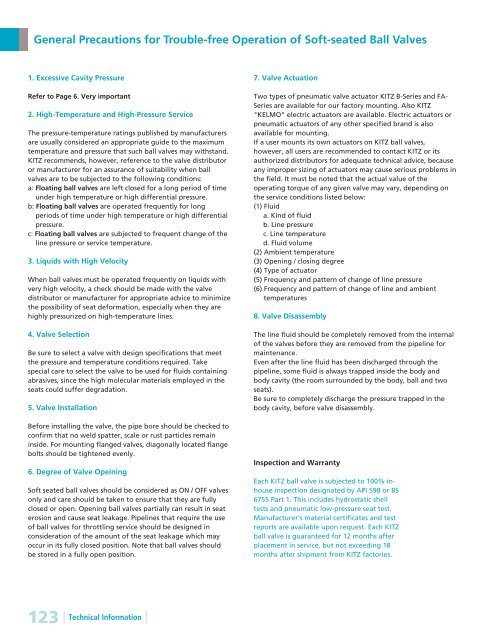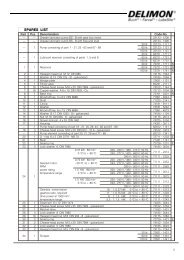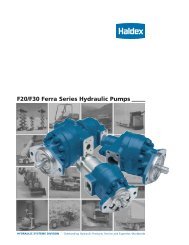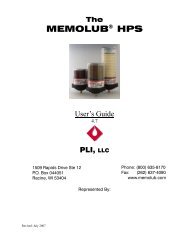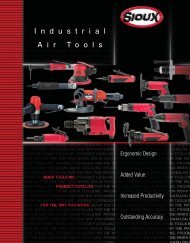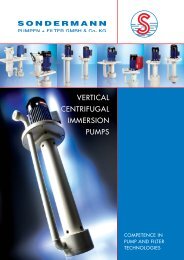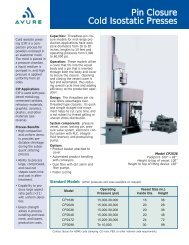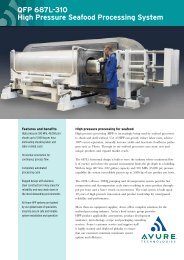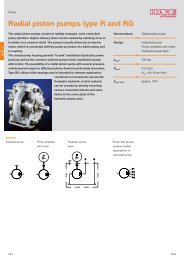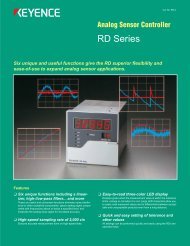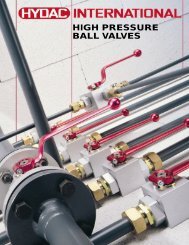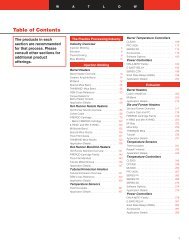Steel Ball Valves - Hasmak.com.tr
Steel Ball Valves - Hasmak.com.tr
Steel Ball Valves - Hasmak.com.tr
You also want an ePaper? Increase the reach of your titles
YUMPU automatically turns print PDFs into web optimized ePapers that Google loves.
General Precautions for Trouble-free Operation of Soft-seated <s<strong>tr</strong>ong>Ball</s<strong>tr</strong>ong> <s<strong>tr</strong>ong>Valves</s<strong>tr</strong>ong><br />
1. Excessive Cavity Pressure<br />
Refer to Page 6. Very important<br />
2. High-Temperature and High-Pressure Service<br />
The pressure-temperature ratings published by manufacturers<br />
are usually considered an appropriate guide to the maximum<br />
temperature and pressure that such ball valves may withstand.<br />
KITZ re<s<strong>tr</strong>ong>com</s<strong>tr</strong>ong>mends, however, reference to the valve dis<strong>tr</strong>ibutor<br />
or manufacturer for an assurance of suitability when ball<br />
valves are to be subjected to the following conditions:<br />
a: Floating ball valves are left closed for a long period of time<br />
under high temperature or high differential pressure.<br />
b: Floating ball valves are operated frequently for long<br />
periods of time under high temperature or high differential<br />
pressure.<br />
c: Floating ball valves are subjected to frequent change of the<br />
line pressure or service temperature.<br />
3. Liquids with High Velocity<br />
When ball valves must be operated frequently on liquids with<br />
very high velocity, a check should be made with the valve<br />
dis<strong>tr</strong>ibutor or manufacturer for appropriate advice to minimize<br />
the possibility of seat deformation, especially when they are<br />
highly pressurized on high-temperature lines.<br />
4. Valve Selection<br />
Be sure to select a valve with design specifications that meet<br />
the pressure and temperature conditions required. Take<br />
special care to select the valve to be used for fluids containing<br />
abrasives, since the high molecular materials employed in the<br />
seats could suffer degradation.<br />
5. Valve Installation<br />
Before installing the valve, the pipe bore should be checked to<br />
confirm that no weld spatter, scale or rust particles remain<br />
inside. For mounting flanged valves, diagonally located flange<br />
bolts should be tightened evenly.<br />
6. Degree of Valve Opeining<br />
Soft seated ball valves should be considered as ON / OFF valves<br />
only and care should be taken to ensure that they are fully<br />
closed or open. Opening ball valves partially can result in seat<br />
erosion and cause seat leakage. Pipelines that require the use<br />
of ball valves for throttling service should be designed in<br />
consideration of the amount of the seat leakage which may<br />
occur in its fully closed position. Note that ball valves should<br />
be stored in a fully open position.<br />
7. Valve Actuation<br />
Two types of pneumatic valve actuator KITZ B-Series and FA-<br />
Series are available for our factory mounting. Also KITZ<br />
"KELMO" elec<strong>tr</strong>ic actuators are available. Elec<strong>tr</strong>ic actuators or<br />
pneumatic actuators of any other specified brand is also<br />
available for mounting.<br />
If a user mounts its own actuators on KITZ ball valves,<br />
however, all users are re<s<strong>tr</strong>ong>com</s<strong>tr</strong>ong>mended to contact KITZ or its<br />
authorized dis<strong>tr</strong>ibutors for adequate technical advice, because<br />
any improper sizing of actuators may cause serious problems in<br />
the field. It must be noted that the actual value of the<br />
operating torque of any given valve may vary, depending on<br />
the service conditions listed below:<br />
(1) Fluid<br />
a. Kind of fluid<br />
b. Line pressure<br />
c. Line temperature<br />
d. Fluid volume<br />
(2) Ambient temperature<br />
(3) Opening / closing degree<br />
(4) Type of actuator<br />
(5) Frequency and pattern of change of line pressure<br />
(6) Frequency and pattern of change of line and ambient<br />
temperatures<br />
8. Valve Disassembly<br />
The line fluid should be <s<strong>tr</strong>ong>com</s<strong>tr</strong>ong>pletely removed from the internal<br />
of the valves before they are removed from the pipeline for<br />
maintenance.<br />
Even after the line fluid has been discharged through the<br />
pipeline, some fluid is always <strong>tr</strong>apped inside the body and<br />
body cavity (the room surrounded by the body, ball and two<br />
seats).<br />
Be sure to <s<strong>tr</strong>ong>com</s<strong>tr</strong>ong>pletely discharge the pressure <strong>tr</strong>apped in the<br />
body cavity, before valve disassembly.<br />
Inspection and Warranty<br />
Each KITZ ball valve is subjected to 100% inhouse<br />
inspection designated by API 598 or BS<br />
6755 Part 1. This includes hydrostatic shell<br />
tests and pneumatic low-pressure seat test.<br />
Manufacturer's material certificates and test<br />
reports are available upon request. Each KITZ<br />
ball valve is guaranteed for 12 months after<br />
placement in service, but not exceeding 18<br />
months after shipment from KITZ factories.<br />
123 021<br />
Technical Information


